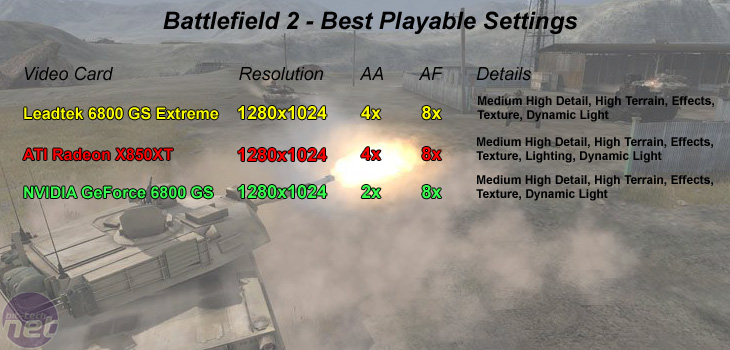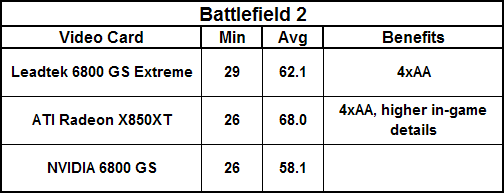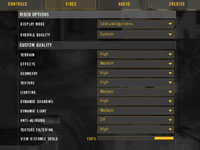Battlefield 2
Publisher: Electronic ArtsBattlefield 2 features an all-new game engine based on the DirectX 9.0 API. There is no Shader Model 3.0 support, but the majority of hardware will use a Shader Model 2.0++ mode that includes support for Normal Maps, Parallax Mapping, Full-Resolution Dynamic Shadowing, Post Processing and Fog.
The game will look the same on both NVIDIA and ATI hardware, so there is no advantage of choosing one over the other in image quality related circumstances. The only major difference is that Ultra Shadow 2 is utilised on NVIDIA's hardware, while the shadowing on ATI hardware is done using a slightly different technique.
We played three five-minute segments of the same map, reporting the median frame rate. We found that there was no ready way to duplicate testing situations manually in this game, so we felt that taking a typical slice of action from the game was the best way to report our findings. We controlled Anti-Aliasing from inside the game, while Anisotropic Filtering was set to 8xAF when the 'Texture Filtering' option was set to 'High'.
Below is a table of the best-playable settings that we found best for each video card configuration. In this title, we found that 25 frames per second minimum and a target of 55 frames per second (or higher) for the average frame rate delivered a good gaming experience on these video cards.


We were able to set terrain, effects, texture and dynamic light options to 'high', while all other settings remained at 'medium'. The detail levels were generally pretty good too - we didn't experience much texture shimmering and, when playing the game, it was reasonably hard to spot in the Strike from Karkand map.
The Radeon X850XT was slightly better than the Leadtek 6800 GS Extreme - we found that we were able to play the game at 1280x1024 4xAA 8xAF with the same settings as the Leadtek card, but with lighting detail set to 'high' too. This didn't make a great deal of difference in the game, but the average frame rate was much higher than what was recorded on the Leadtek card and the gaming experience was very smooth. It was a rare sight to see the frame rate drop below 40 frames per second, with only a single slip below 30 frames per second in our manual gameplay evaluations.
The NVIDIA reference GeForce 6800 GS was the slowest of the bunch, but it still delivered a good gaming experience at 1280x1024 2xAA 8xAF with the same detail settings as the Leadtek card. Even with the lower detail, both the average and minimum frame rates were still lower than what we achieved with the other two cards tested.

MSI MPG Velox 100R Chassis Review
October 14 2021 | 15:04







Want to comment? Please log in.